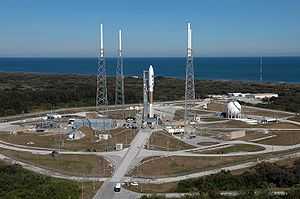Cape Canaveral Air Force Station Space Launch Complex 41
 | |
| Launch site | Cape Canaveral Air Force Station |
|---|---|
| Location | 28°35′00″N 80°34′59″W / 28.58333°N 80.58306°WCoordinates: 28°35′00″N 80°34′59″W / 28.58333°N 80.58306°W |
| Short name | SLC-41 |
| Operator | United States Air Force |
| Total launches | 69 |
| Launch pad(s) | 1 |
| Minimum / maximum orbital inclination | 28° - 57° |
| Launch history | |
| Status | Active |
| First launch | 21 December 1965 Titan IIIC / LES-3/4 |
| Last launch | 13 March 2015 Atlas V / MMS |
| Associated rockets | Titan IIIC Titan IIIE Titan IV Atlas V (current) |

Cape Canaveral Air Force Station Space Launch Complex 41 (SLC-41), previously Launch Complex 41 (LC-41), is an active launch site at the north end of Cape Canaveral, Florida at Cape Canaveral Air Force Station.[1][2] The site is currently used by United Launch Alliance for Atlas V launches. Previously, it had been used by the Air Force, for Titan III and Titan IV launches.
Titan III
The Titan III launch facilities at CCAFS were built as part of an Integrate-Transfer-Launch approach intended to enable a rapid launch rate. Titan vehicles were assembled and integrated with their payloads off-pad and then transported by rail to one of the two pads. The Titan III facilities included both LC-40 and LC-41, assembly buildings including the Vertical Integration Building, and the first rail line at the Cape.[3] The facilities were completed in 1964, and the first launch from LC-41 was of a Titan IIIC, carrying four separate payloads, on December 21, 1965.
Titan IV
LC-41 was also the pad used for the maiden flight of the Titan IV. The last Titan launch from LC-41 was on April 9, 1999, when a Titan IVB launched the USA 142 early warning satellite. This launch resulted in a failure, after the IUS upper stage failed to separate, leaving the payload stranded in a useless GTO orbit.
Atlas V
After the last Titan launch, the complex was renovated, and since 2002, LC-41 has been used by ULA for Atlas V launches. The maiden flight of Atlas V launched from LC-41 on August 21, 2002. The Atlas V booster lifted Hot Bird 6, a Eutelsat geostationary communications spacecraft built around a Spacebus 3000B3 bus.
Atlas V rockets are assembled vertically on a mobile launch platform in the Vertical Integration Facility, located to the south of the pad. The platform is transported to the launch pad on rails, around a day before launch.
Payloads
In addition to satellites, Titan vehicles launched several probes from LC-41 in the 1970s, including the Helios probes to study the Sun, the Viking probes to Mars, and the Voyager planetary flyby and deep-space probes. More recent probes have also been launched from LC-41 using the Atlas V: the Mars Reconnaissance Orbiter in December 2004, the New Horizons spacecraft to Pluto in January 2006, Juno mission to Jupiter in August 2011,[4] and Mars Science Laboratory to Mars in November 2011.[5][6]
See also
References
- ↑ McDowell, Jonathan (1998-02-22). "Issue 350". Jonathan's Space Report. Jonathan's Space Page. Retrieved 2009-07-09.
- ↑ USAF Supports NASA's Dual Lunar Exploratory Missions
- ↑ Roy McCullough (September 2001). "Missiles at the Cape". US Army Corps of Engineers.
- ↑ 45th Space Wing Supports Successful Atlas V Juno Launch
- ↑ The Associated Press (November 26, 2011). "NASA Launches Sophisticated Rover on Journey to Mars". The New York Times. Retrieved November 26, 2011.
- ↑ NASA Offers Media Access To Mars-Bound Rover On Aug. 12
External links
| Wikimedia Commons has media related to Cape Canaveral Air Force Station Space Launch Complex 41. |
| ||||||||||||||